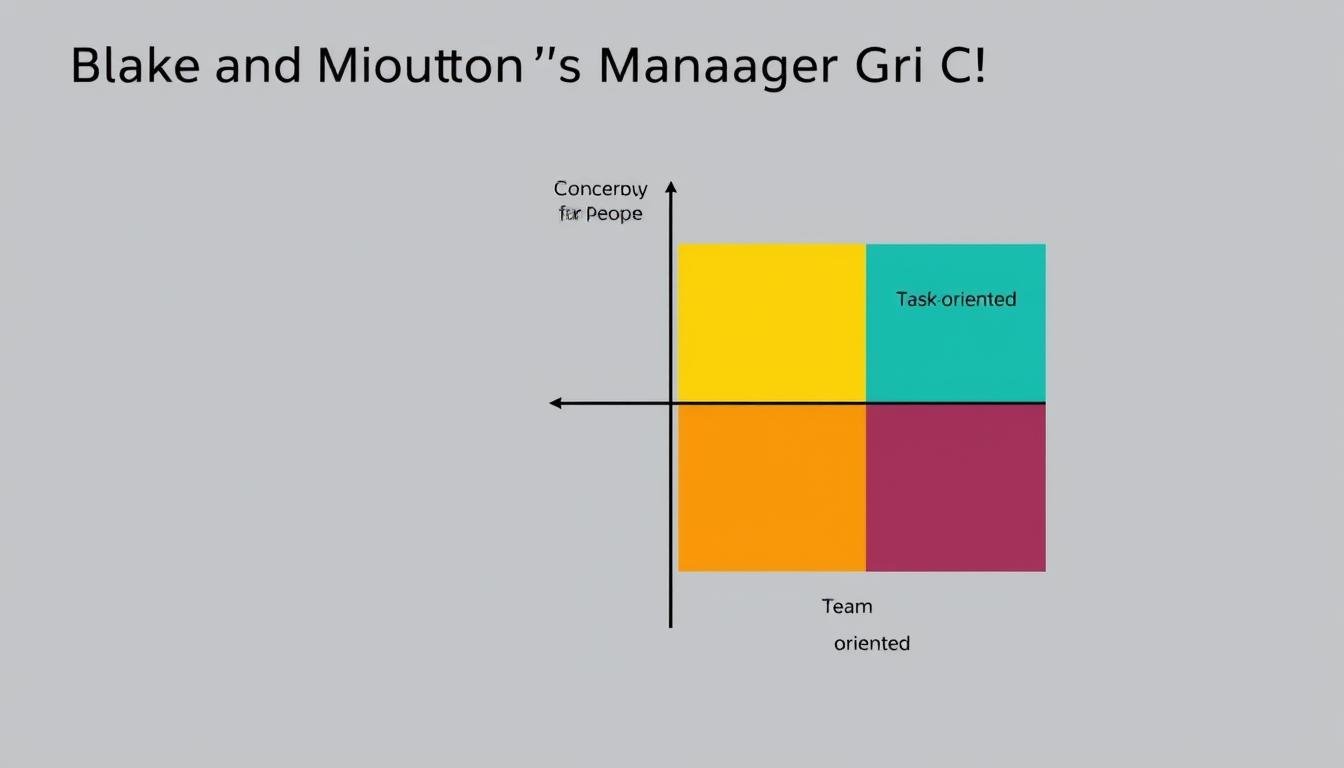Exploring Blake and Mouton’s Managerial Grid Essentials
Ever wondered why some leaders do great while others struggle? It’s all about their leadership style. The Blake and Mouton’s Managerial Grid shows how different leadership styles work. It looks at how much leaders care about people and production. This theory, from the 1960s, helps us see what makes a leader successful.
This article will explain the Managerial Grid’s key points. It shows how knowing about different leadership styles can help teams work better together. Being a good leader is not just about doing tasks. It’s also about how you connect with your team.
Key Takeaways
- The managerial grid model categorizes leadership into five styles based on concern for people and tasks.
- Impoverished Management leads to chaos due to low concern for tasks and people.
- Team Management blends high concern for production and people, yielding optimal results.
- Flexibility in leadership styles can significantly enhance managerial effectiveness.
- Self-awareness and leadership development are crucial for transitioning towards effective management styles.
- Understanding individual leadership styles can help managers strive towards a more balanced approach.
The Fundamentals of Leadership Styles
Leadership styles shape how managers work with their teams and tasks. They focus on two key areas: concern for production and concern for people. These dimensions help us see the different leadership styles that work well in different settings.
Understanding the Dimensions of Leadership
The Blake and Mouton Managerial Grid looks at leadership styles on a nine-point scale. It measures concern for production and people. Production focus is about getting tasks done well. People focus is about keeping the team happy and motivated.
This grid shows five main leadership styles:
- Impoverished Management (1,1)
- Produce-or-Perish Management (9,1)
- Middle-of-the-Road Management (5,5)
- Country Club Management (1,9)
- Team Management (9,9)
Team Management is seen as the best style. It balances both production and people focus for high effectiveness. Other styles might focus more on one, affecting team work and productivity.
Importance of Balancing Task and People Concerns
A good leader balances both production and people focus. This approach helps teams work better and be more productive. It leads to happier workers and better results.
The Blake and Mouton Grid is a useful tool for managers. It shows their strengths and areas to improve. This helps in making work processes and motivation better, making the workplace better for everyone.
| Leadership Style | Concern for Production | Concern for People | Managerial Effectiveness |
|---|---|---|---|
| Impoverished Management | Low (1) | Low (1) | Low |
| Produce-or-Perish Management | High (9) | Low (1) | Moderate |
| Middle-of-the-Road Management | Medium (5) | Medium (5) | Average |
| Country Club Management | Low (1) | High (9) | Moderate |
| Team Management | High (9) | High (9) | High |
Choosing the right leadership style means finding a balance between production and people focus. Using the Blake and Mouton Managerial Grid helps improve leadership in different settings.
Blake and Mouton’s Managerial Grid Explained
The Blake and Mouton Managerial Grid is a key leadership model. It shows different managerial styles by looking at two main things: how much a manager cares about making things and how much they care about people. This grid uses a nine-point scale to place managers into different leadership types. It helps managers see their own leadership style and find ways to get better.
Overview of the Managerial Grid Model
This grid highlights five main leadership styles. It shows how these styles affect the success of a team and how happy the employees are. Managers can see where they stand on the grid and work on improving. They can think about how their style fits into the dual concern model.
Two Key Dimensions: Concern for People and Concern for Production
Leaders focus on people and production in different ways. People focus is about caring for the team and building relationships. Production focus is about getting tasks done. Each style on the grid shows how a manager balances these two areas. For example:
| Leadership Style | Concern for People | Concern for Production |
|---|---|---|
| Impoverished Management | 1 | 1 |
| Country Club Management | 9 | 1 |
| Authority-Compliance Management | 1 | 9 |
| Middle-of-the-Road Management | 5 | 5 |
| Team Management | 9 | 9 |
Knowing where a manager’s style fits in the Blake Mouton grid helps them make better plans for their team and work. This leadership model gives managers tools to check their current ways and grow in the future.
Five Leadership Styles in the Managerial Grid
The Managerial Grid by Blake and Mouton breaks down leadership styles into five main types. Each style shows different levels of focus on tasks and people. Knowing these styles helps leaders pick the best approach for the situation.
Impoverished Management (1,1)
This style means managers don’t care much about tasks or people. It leads to a chaotic work environment, causing people to feel unengaged and lost. This approach is seen as poor because it results in low performance and unhappy workers.
Country Club Management (1,9)
Country Club Managers focus on making their team happy rather than getting tasks done. This creates a friendly place to work but can hurt productivity. Leaders using this style might struggle to achieve their goals, showing the challenge of balancing different leadership styles.
Task Management (9,1)
Task Managers are all about getting things done, often ignoring team members’ needs. This leads to quick results but can cause low morale and high turnover. It’s an extreme focus on tasks within the grid.
Middle-of-the-Road Management (5,5)
Middle-of-the-Road Managers aim for a balance between focusing on tasks and people. But this can lead to just average performance. It shows the challenge of finding the right balance in leadership.
Team Management (9,9)
Team Management is seen as the best leadership style. It combines a strong focus on people and high productivity. Leaders who use this style are democratic, which keeps their team engaged and leads to great results. This approach can greatly improve a company’s success.
Applying the Blake and Mouton’s Managerial Grid in Organizations
The Blake and Mouton Managerial Grid is a key tool for improving leadership in companies. It shows five different leadership styles: Impoverished Management, Country Club Management, Authority-Compliance Management, Middle-of-the-Road Management, and Team Management. Leaders learn about their style and how it affects their team.
This self-reflection helps managers see their default style and how to get better. It’s a step towards better leadership.
Self-Assessment and Leadership Development
Self-assessment lets leaders think about their leadership and where they stand in the grid. It helps them grow and find areas to improve. Using the situational leadership model, managers can change their style to fit their team’s needs. This leads to better results.
Flexibility in Leadership Styles for Organizational Behavior
Leaders need to be flexible in today’s changing work world. They face different challenges and team dynamics that call for a change in their style. The Blake and Mouton Grid shows the importance of being adaptable.
It encourages leaders to switch styles to meet the situation. This flexibility boosts both individual and team performance.
Impact on Managerial Effectiveness
Using the Blake and Mouton Grid makes managers more effective. Focusing on both tasks and people makes the workplace better. Teams work better, communicate better, and perform better.
Leaders who focus on both people and production create a positive work environment. This approach makes employees feel important and motivated. It leads to success for the whole organization.
Conclusion
Blake and Mouton’s Managerial Grid is key to improving leadership in different work settings. It shows how leaders need to balance task focus and people care. This theory gives managers tools to improve their leadership skills.
The five leadership styles it presents offer insights into managing teams well. They help leaders deal with the challenges of team management.
As work environments change, leaders must master this balance. A good leader helps teams achieve goals and creates a positive workplace. Using the Managerial Grid can help leaders face today’s work challenges.
For leaders wanting to make a bigger difference, knowing the Managerial Grid is crucial. By assessing themselves and changing their leadership style, leaders can build strong teams. These teams are productive, happy, and resilient.
Source Links
- Blake and Mouton’s Managerial Grid: A Simple Summary – The World of Work Project
- Understanding the Blake and Mouton Managerial Grid
- Blake and Moutons Managerial Grid
- What is the managerial grid model (The Blake and Mouton Managerial Grid Model)? | Definition from Te
- Leadership Grid: Definition of the Model and Five Behavior Types
- SYMLOG and Blake and Mouton Leadership Grid
- Blake Mouton Leadership Grid- Styles and their Polarities
- Blake And Mouton Managerial Grid
- Blake Mouton Grid: 5 Leadership Types for People and Production
- Blake and Mouton’s Managerial Grid Explained by a CEO, examples, pros/cons
- Blake-Mouton’s Managerial Grid Theory
- Critical Evaluation of Blake And Mouton’s Managerial Grid and Its Application To Baze University Library
- Managerial Grid by Blake and Mouton







